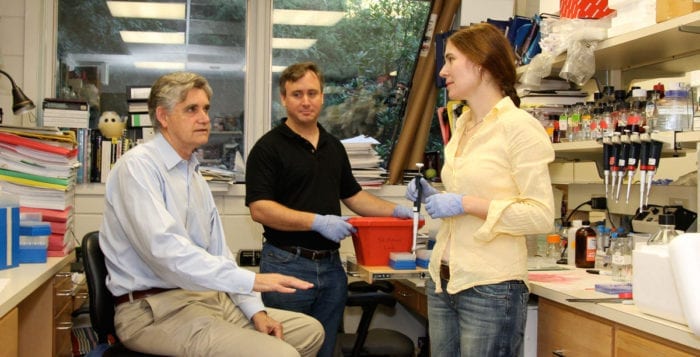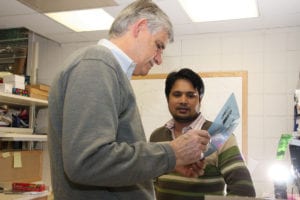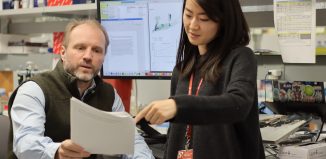CSHL’s Stillman’s two-year stint now in its 36th year

When he was 11, Bruce Stillman read about spina bifida and wanted to know what was happening and how he might help. By the time he got to college, genetic discoveries moved him away from medicine and toward scientific discovery.
In 1979, he came to Cold Spring Harbor Laboratory from his native Glen Waverley through Sydney, Australia, for what he expected would be just two years. At the time, the lab was led by Nobel-prize-winning scientist James Watson, who discovered the structure of DNA the year Stillman was born.
By the time he was 38, Stillman’s research success led Watson to pick him as his successor to lead an institution with an international reputation.
Now in his 36th year at Cold Spring Harbor Laboratory and with children and a grandchild born in the United States, Stillman has trained a generation of scientific leaders while maintaining two time- and energy-consuming jobs.
“I spend 80 percent of my time” on being the president and chief executive officer of CSHL and “the other 80 percent running the lab,” he jokes.
Former members of Stillman’s lab and collaborators have marveled at Stillman’s ability to continue to remain so active in his scientific pursuits while raising funds, hiring researchers and overseeing a lab with an endowment of $450 million, up from $32 million in 1994.
Stillman, his colleagues say, has a passion for discovery and a dedication to science that informs both sides of a schedule that often includes discussions, meetings and interactions during what many would consider off hours.

Leemor Joshua-Tor, a professor at CSHL who has collaborated with Stillman for about nine years, has interacted with Stillman as an administrator and as a scientist. She says it’s clear which role wins out.
When Joshua-Tor was the dean of the Watson School of Biological Sciences, she would email him in his capacity as president. She would often get a time slot three or four weeks from her request.
“If I called/emailed and said I would like to speak with him regarding the science, the reply would often be, ‘How’s 4 p.m.?’” Joshua-Tor recounted.
Stillman said that continuing in his role as a scientist helps him make better decisions for CSHL. He has a “connection with what’s going on” scientifically that informs his pursuit of scientific expertise and new technology, he said.
Stillman has also forged numerous connections with the people who work at CSHL. Joshua-Tor said he knows most people by name, from the grounds keepers to the graduate students to the postdoctoral researchers, a skill she said also follows Watson’s legacy.
In his long, storied and award-winning career, Stillman has worked with viruses, yeast and human DNA, making landmark discoveries that include using the Simian Virus 40 to discover human cell DNA replication proteins.
Stillman “covered many areas during his career that make him special,” said Christian Speck, a nonclinical lecturer in the Faculty of Medicine at the Institute of Clinical Sciences at the Imperial College in London who earned his Ph.D. in Stillman’s lab in 2006 and who collaborates with Stillman.
Huilin Li, a biophysicist at Brookhaven National Laboratory and a professor of biochemistry and cell biology at Stony Brook University, said Stillman’s discovery of the Origin Recognition Complex, abbreviated ORC, “set off an entire research field of eukaryotic DNA replication initiation.”
Indeed, Stillman, Li, Speck, Joshua-Tor and others continue to devote considerable energy to understanding the protein, signals and processes that are a key part of DNA replication, which allows cells to make genetic copies of themselves.
Replication makes it possible for the body to produce red and white blood cells at the rate of 500 million per minute. Spreading the spectacularly thin, tightly wrapped genetic material out over that minute would produce a million kilometers of base pairs, which could wrap around the equator 25 times.
Replication isn’t just important for passing along information, but, as Stillman recognized when he was 11, biological processes don’t always follow the typical code.
Stillman and his collaborators have explored numerous ORCs, which occur once every 50,000 to 100,000 base pairs along the chromosome. His recent studies suggest the ORC is involved in the fundamental decision of whether or not a cell divides.
His recent unpublished findings also show that ORC controls the expression of genes that are overexpressed in cancer by interacting with tumor suppressor genes, he said.
Understanding how DNA replication is regulated has already produced drugs that are in the clinic or are heading that way, Stillman said.
Through his years at CSHL, Stillman has worked with talented scientists. His lab was near that of Barbara McClintoch, who won a Nobel Prize for her work on jumping genes in corn. While Stillman said he enjoyed most of his interactions with her, he did struggle on occasion to return to his own research, which could often take 12 to 14 hours a day, after a long discussion with her.
Avoiding McClintoch during those long research days was no easy task for the six-foot, four-inch scientist, whose tall, trim figure is easy to spot down a hallway or in the picturesque CSHL laboratory setting.
Stillman met his wife Grace, a co-founder of Operation Hearts and Homes, a charity dedicated to improving the lives of orphans around the world, in Huntington. Their son Keith is a commercial real estate appraiser and their daughter Jessica is a fifth-grade teacher specializing in literacy.
Stillman, who has no plans to step away from either role in the near future, suggested that the scientific process, though demanding, has given him numerous rewarding experiences. In the 1980s, he made a hand drawing of how he thought histones, the fundamental building block of chromatin, might get together. About a decade later, X-ray crystallography showed that the drawing was close to accurate.
“It was how I imagined it to be,” he recalled. These discoveries provide “excitement and then with the new insight, [a desire to] get to a full answer quickly.”






